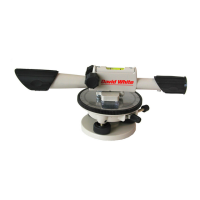-10-
Levels and level-transits, as do all sighting
instruments, operate on the principle
that any point along a level line of sight is
exactly level with any point along that line.
Horizontal Level Applications
(L6-20 and LT6-900)
The following jobs can be accurately
performed with a level or level-transit
used in the level position (with closed
lock lever): grading for swimming pools,
driveways, sidewalks, lawns, gardens;
plotting contour plowing lines; laying out
drainage ditches; setting fence lines;
estimating cut and fill requirements;
setting forms and footings; leveling walls
and foundations; establishing drainage
for landscaping; aligning trees and shrubs
and building terraces and stone walls.
Determining differences in
elevation
One of the main uses of levels is for
measuring the differences in elevation for
grading.
With the instrument leveled, we know that
since the line of sight is perfectly straight,
any point on that line of sight will be
exactly level with any other point.
A
B
AB
1
2
4
3
105°
90°
120°
45°
105°
90°
120°
45°
A
B
C
The above illustration shows how exactly
we can check the difference in height (or
elevation) between two points. If the rod
reading at B is 5 ft (1.5 m) and the reading
at C is 6 ft (2 m), we know that point B is
1 ft (0.3 m) higher than point C. Using the
same principle, you can easily check if
a row of windows is straight, or a wall is
level, or how much a driveway slopes.
Running Straight Lines
with a Level
Set up the instrument over Point A. A
plumb bob should be held over Point B.
Sight approximately on the plumb bob
cord and turn the telescope so that the
vertical cross hair coincides with it.
A
C
E
G
H
F
B
D
BACDE
6’
(2 m)
5’
(1.5 m)
AB
1
2
4
3
105°
90°
120°
45°
105°
90°
120°
45°
A
B
C
To align the intermediate points, direct the
person with the leveling rod to the right or
left until the rod coincides with the vertical
cross hair. It is important not to move the
instrument during operation.
After all points have been set, check back
on point B to be sure that the instrument
did not move.
Determining Contour Lines
Contour lines, such as used for contour
plowing, are lines connecting points of
equal level. To determine contour lines,
first level the instrument carefully.
A sighting rod should be held at the
beginning contour line about 100 feet
from the instrument. Sight the rod and set
a target on the rod at the point where the
horizontal cross hair intersects the rod.
Then move the rod to approximately the
next place where a contour line stake is
to be set and move the rod up or down
the slope until the line of sight through the
telescope again intersects the target.
GENERAL APPLICATIONS

